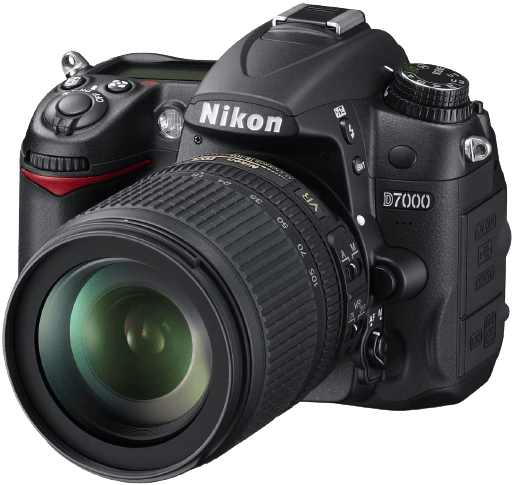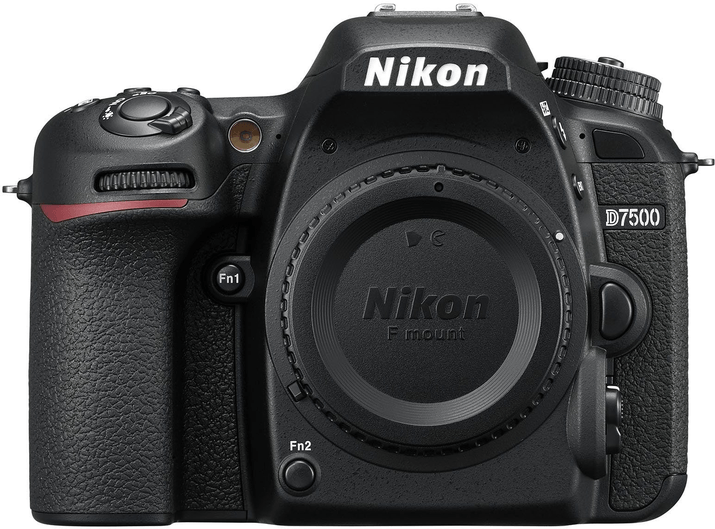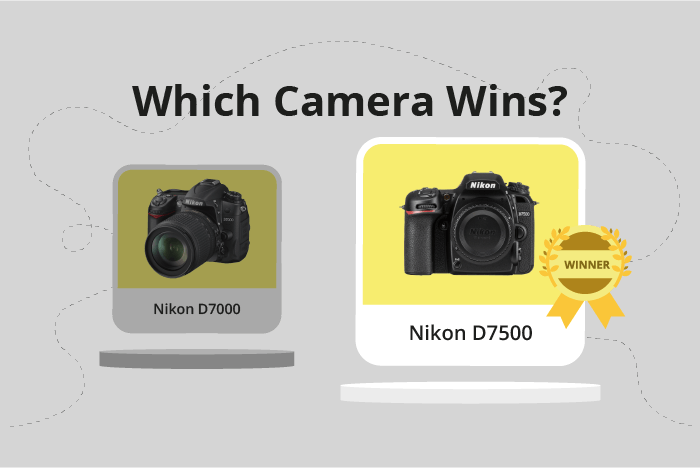Nikon D7000 vs D7500 Comparison
Nikon D7000

Nikon D7500

The Nikon D7500 emerges as the winner with a score of 70, while the Nikon D7000 lags behind with a score of 56. Both cameras are DSLR types and share some common specifications. They have similar camera sizes, with the D7500 being slightly larger at 136 x 104 x 73mm compared to the D7000’s 132 x 105 x 77mm. However, the D7500 is lighter, weighing 720g (1.59lbs) compared to the D7000’s 780g (1.72lbs).
The D7500’s higher score is due to its more advanced features and improvements over the D7000. Released in 2017, it is a more recent model. The D7000, on the other hand, might be preferred by those on a tighter budget or who do not require the latest features.
Considering each camera’s specifications, the Nikon D7500 stands out as the better choice for those seeking a lighter and more advanced DSLR, while the D7000 remains a viable option for budget-conscious buyers.
Nikon D7000 vs D7500 Overview and Optics
The Nikon D7500 emerges as the winner in the optics comparison with a score of 68/100, while the Nikon D7000 lags behind with a score of 55/100. Both cameras share some common specifications, including a CMOS sensor, APS-C sensor size, Nikon F lens mount, and lack of image stabilization.
The D7500’s superior performance is due to its higher megapixel count of 20.9 compared to the D7000’s 16.2, which allows for more detailed and sharper images. Additionally, the D7500 boasts a faster shooting speed of 8 frames per second, compared to the D7000’s 6, enabling the capture of fast-moving subjects with greater ease. The D7500’s Expeed 5 processor further contributes to its better performance, providing quicker processing of images and better noise reduction. The DXOMARK score of 86 for the D7500’s sensor also supports its superior image quality compared to the D7000’s score of 80.
In contrast, the D7000 has few advantages over the D7500. Both cameras have the same lens mount and lack image stabilization, which means that their lenses are interchangeable and neither camera has an edge in terms of lens choices or stabilization. The D7000’s lower score and older technology make it a less desirable option for photographers seeking better image quality and performance.
To sum up, the Nikon D7500 outperforms the Nikon D7000 in terms of optics, with a higher megapixel count, faster shooting speed, and a better processor. The D7000, however, offers no significant advantages over the D7500. Consequently, photographers should opt for the D7500 to achieve better image quality and overall performance.
Nikon D7000 vs D7500 Video Performance
The Nikon D7500 outperforms the Nikon D7000 in video capabilities with a score of 70 out of 100, compared to the D7000’s score of 57. Both cameras share some common specifications, such as having built-in time-lapse functionality. However, the D7500 has distinct advantages that contribute to its higher score.
The winning camera, Nikon D7500, offers 4K video resolution and maximum video dimensions of 3840 x 2160. This higher resolution provides more detailed and sharper video quality. Additionally, the D7500 has a maximum video frame rate of 30fps, which allows for smoother video playback and better motion capture than the D7000’s 24fps.
On the other hand, the Nikon D7000’s video capabilities are limited to Full HD resolution with maximum video dimensions of 1920 x 1080. Despite this disadvantage, the D7000 still delivers decent video quality for casual users and may be suitable for those who do not require 4K resolution.
In comparing the video capabilities of the Nikon D7000 and D7500, it is clear that the D7500 is the superior choice. With 4K resolution and a higher frame rate, the D7500 offers improved video quality and smoother playback. While the D7000 may be sufficient for casual users, those seeking better video performance should opt for the D7500.
Nikon D7000 vs D7500 Features and Benefits
The Nikon D7500 outperforms the Nikon D7000 in features with a score of 83/100 compared to the D7000’s 54/100. Both cameras share some common specifications, such as screen size, screen resolution, lack of GPS, and the presence of WIFI. The D7000 has a 3-inch screen with 921,000 dots resolution, while the D7500 slightly surpasses it with a 3.2-inch screen and 922,000 dots resolution.
The D7500 excels with its additional features, including a touchscreen, flip screen, and Bluetooth connectivity. The touchscreen enables users to navigate menus and review images with ease. The flip screen enhances the camera’s flexibility, allowing for creative angles and improved visibility in challenging shooting situations. Bluetooth connectivity ensures seamless transfer of images to compatible devices, making it easier to share and store photos.
On the other hand, the D7000 has limited advantages over the D7500. Its only notable feature is WIFI connectivity, which is also present in the D7500. The D7000 does not offer any additional features that make it superior to the D7500.
Considering the differences in features, the Nikon D7500 is the clear winner in this comparison. Its touchscreen, flip screen, and Bluetooth connectivity provide users with a more convenient and versatile shooting experience. The Nikon D7000, although equipped with WIFI, fails to offer any unique advantages over the D7500. Therefore, the D7500’s higher feature score of 83/100 is justified, as it offers a better user experience with its additional features.
Nikon D7000 vs D7500 Storage and Battery
The Nikon D7000 outperforms the Nikon D7500 in storage and battery, scoring 79/100 compared to the D7500’s 43/100. Both cameras share similarities in this aspect, as they each accept SD, SDHC, and SDXC memory cards. The D7000 has dual memory card slots though. Neither camera offers USB charging.
The D7000 has a longer battery life of 1050 shots, 100 shots more than the D7500’s 950 shots. This advantage allows photographers to capture more images before needing to replace the battery. However, the D7500 uses a newer battery type, the EN-EL15a, which may provide improved performance in some situations.
Despite the D7000’s slightly higher score, both cameras have similar storage and battery capabilities. The D7000’s longer battery life may be beneficial for some users, while others may find the D7500’s newer battery type more appealing. Ultimately, the choice between the two largely depends on individual preferences and needs.
Nikon D7000 vs D7500 – Our Verdict
Are you still undecided about which camera is right for you? Have a look at these popular comparisons that feature the Nikon D7000 or the Nikon D7500:

